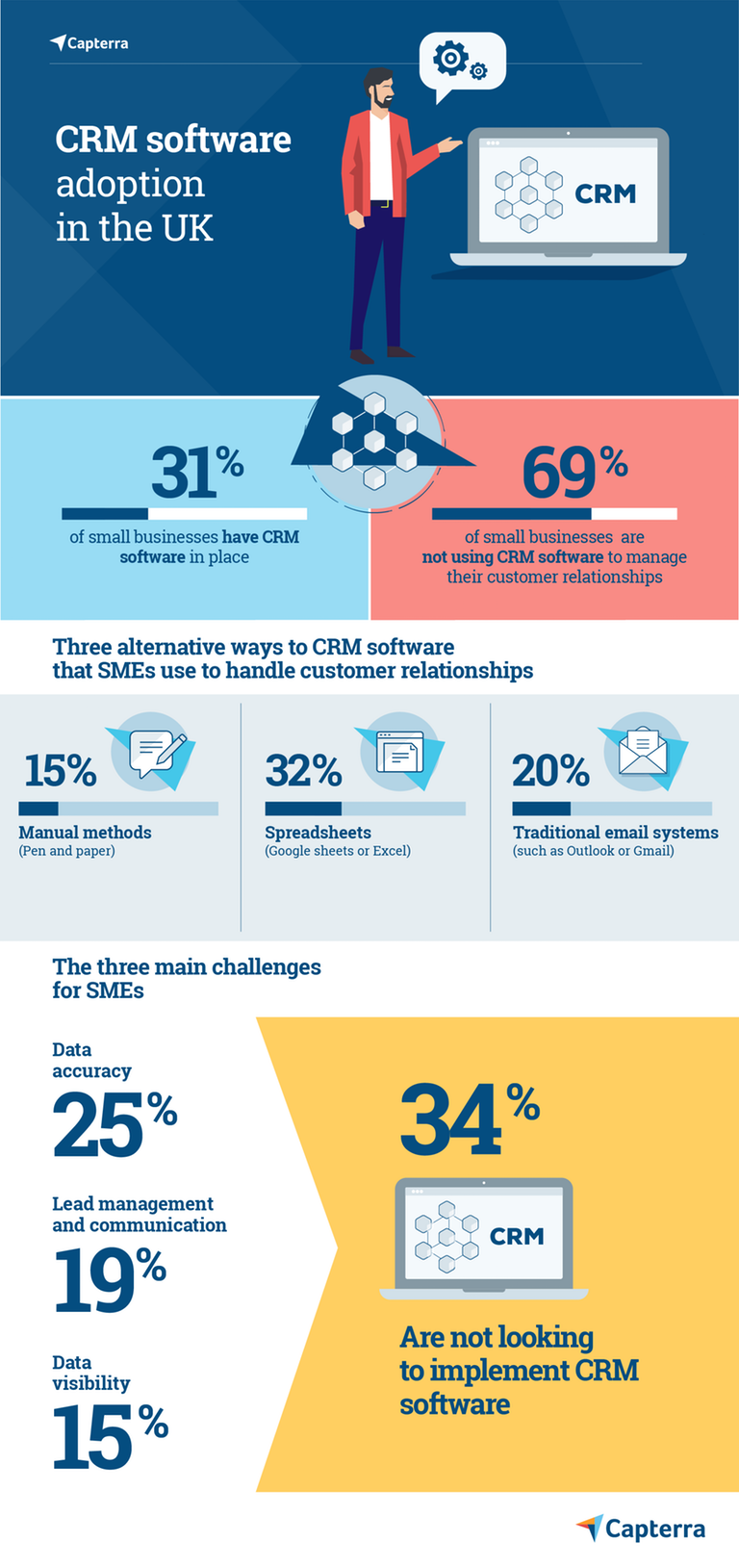Why do CRM systems fail? There are plenty of reasons. Were your business objectives clear? Did the CRM integrate with the rest of your business platforms? Had you recently reviewed your process? And was the sales team actually on board in the first place?
Alone, any one of these reasons could explain why your CRM wasn’t in a good place to drive success. If you’re shaking your head to a few of them, the project was likely in trouble from the start.
Research found that 69% of UK SMEs still operate without a CRM system in place. Yet data accuracy (25%) and lead management (15%) are the biggest challenges they face.
"There’s a misconception that CRM software is expensive, so many organisations are still relying on manual methods that lead to errors."
Although CRM software greatly improves customer data accessibility, this is meaningless if there's a big misunderstanding as to how it all works and what's required of the people who need to use it. For example, some people may only see a CRM as a glorified address book and fail to use the system to its full potential.
One of the major consequences of a failed CRM project is people become sceptical of the system altogether, which makes it difficult to try making a case to set one up again in the future. Implementing a CRM isn’t something you do on a whim. Executing it correctly takes careful consideration, planning, and training.
INFOGRAPHIC: the state of CRM software adoption in the UK

Why do CRM systems fail?
The CRM deployment process is a time-consuming project requiring a lot of thought and preparation, which is why it’s important to identify early on whether or not you’re on track for success.
The following are some of the most common factors that contribute to a CRM failure as well as the actions you can take to be proactive and avoid any missteps.
1. No CRM strategy or business objectives
Implementing a CRM isn’t something you figure out as you go along. Having measurable objectives that you can track and analyse will help you measure revenue impact, calculate ROI, and see whether your CRM is failing, for instance. A strategy is essential when it comes to managing and monitoring information in the database for any inconsistencies, errors, and redundant pieces of data.
You should be planning a solution that fits your needs as a business. Flying by the seat of your pants and adding features here and there without any real implementation strategy or process will lead to a never-ending CRM rollout and people giving up on using the system altogether.
You must know what you want your CRM to accomplish for the business, such as how your employees will use the system and how it will help you to hit your KPIs.
"A solid CRM strategy must have growth in mind, there needs to be plenty of room for expansion and updating processes."
You can break-up the implementation process into steps and set realistic timelines. For example, setting aside an appropriate amount of time dedicated to staff training and user testing.
For more on putting in place an effective strategy, read our latest page on data-driven marketing.
2. Lack of user adoption
It can be challenging to accept change, especially when it comes in the form of a new CRM, with new processes, responsibilities, and a steep learning curve. Implementing a CRM means shifting the way your sales team organises its contacts and prioritises its work, which means there could be quite a bit of resistance to this type of change.
When there is an absence in user adoption, it often means people in your business haven’t been adequately trained and struggle to understand how the CRM is integrated with existing workflows and processes.
A lack of training and understanding of the system is discouraging to users and would result in a significant decrease in adoption rates and a higher chance at the CRM failing. Without it, people won’t be committed to inputting their data consistently, they might only do it periodically once a week or even store it elsewhere such as in a spreadsheet or notebook. It makes it difficult to draw insights from data if only some people are using the CRM which could then result in inconsistencies and gaps in information.
The right support and training must be put in place to incentivise people to use the system. Make it user-friendly and encourage buy-in so that the CRM may be used to its full potential.
To avoid resistance, understand the reasons why your sales team might reject the idea of using the CRM. Be specific and transparent with them:
- How will it impact their work?
- What is expected of them?
- What changes will need to be made?
Show them the benefits of using the system as a primary data source. The better they understand the value, the more invested they will be in adopting the CRM.
3. Integration failures
An integrated platform means that all the data your company generates is stored in one place and can be accessed and analysed across the business. However, if the data related to your business is scattered and stored in multiple places (spreadsheets, notebooks, diaries etc.) and your technology isn’t speaking to each other, then it makes it difficult to draw any meaningful insights from the data in the CRM. For instance, if your revenue forecasts are done in another system, you’ll need to figure out how it will be integrated with the CRM.
"The CRM must be the primary source of data at the centre of your business and fit in with all other existing systems so the technology is connected."
4. Outdated business processes
If you only update your business processes every four to five years, then you’ll most likely have a few errors in your CRM data. At BabelQuest, to stay on top of updates, we set up a process hackathon every 4-5 months to go over any company processes that may need reviewing. This is something you can do within your own business. Assign each team (marketing, sales, services, operations) their own processes and work together to make any necessary changes. Make sure to review processes that have anything to do with CRM implementation, migration and training, as these can make or break the success of your CRM.
As we mentioned before, the CRM should be the primary data source, which means it needs to be embedded in all business processes, most importantly sales.
"When the CRM is used properly, sales reps are able to shorten their sales cycles by 8 -14%. "
Instead of adding data once every other week based on a vague memory and scribbled notes, they must follow a standard process of consistently inputting data at the end of every day and review the pipelines, sales activity, and new contacts once a month.
The sales team needs to be constantly cycling through the data in the CRM to monitor if contacts are still engaging, whether any of them have a history of bouncing and eliminating contacts that are no longer relevant.
Need to improve your HubSpot CRM to generate more leads that close? Contact us for a free CRM audit.
What are your key issues when implementing a CRM?
Don’t let these common mistakes intimidate you. Dismissing the development of a CRM strategy, ignoring low user adoption rates, allowing integration failures and keeping outdated business processes are factors you can avoid with proper thought, planning and effective CRM preparation, training and user testing.
The question of why CRM implementations fail is rarely simple. But by being aware of the common ways a CRM can let you down, you can be better prepared when implementing your own CRM to ensure its success.
For more on coming up with a successful data strategy, using your CRM to its full potential, making sure your technology talks to each other and turning your data into actionable insights. Read our latest guide, ‘From Data to Insight to Action’.
Download Data to Insight to Action
Elevate your decision-making with our latest eBook - 'Data Insight Action.' Download now to unlock the secrets of turning data into actionable insights.


Tom is BabelQuest's Principal Copywriter. He has a PhD in Creative Writing from the University of Southampton and is a novelist with Sparkling Books.
![Why Do CRM Systems Fail [and How to Successfully Implement Yours] Why Do CRM Systems Fail [and How to Successfully Implement Yours]](https://www.babelquest.co.uk/hs-fs/hubfs/Why%20CRMs%20let%20you%20down-1-1.jpeg?width=800&name=Why%20CRMs%20let%20you%20down-1-1.jpeg)


.png?width=50)

.png?width=50)
.png?width=50)


































